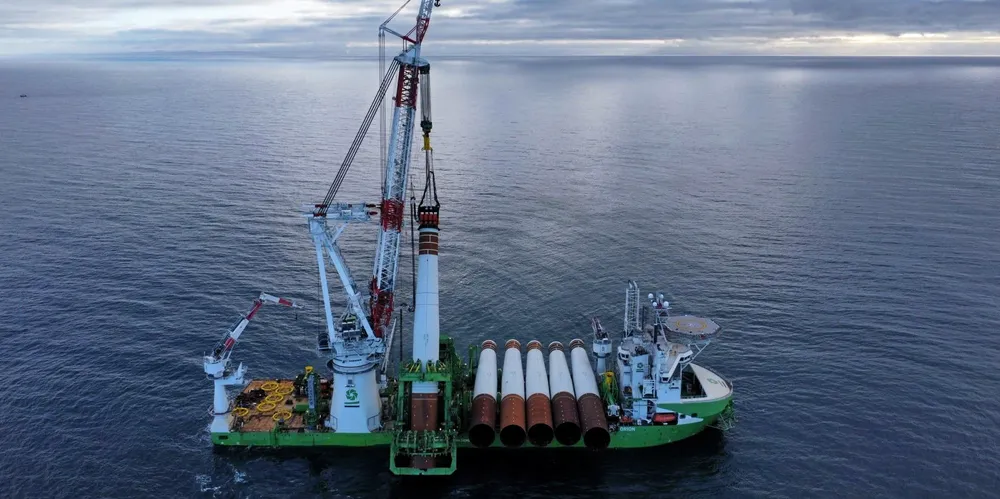Vessel shortage 'could wipe out 40% of fixed-bottom offshore wind ambitions'
Global ex-China fleet of heavy-lift vessels is growing but can't keep up with demand, says maritime analyst

A global pipeline of fixed-bottom offshore wind projects that could quintuple operating capacity by 2030 will achieve less than 60% of this potential due to a shortage of heavy installation vessels, according to the latest forecast by maritime market intelligence firm Spinergie.
In projections that took account of different levels of confidence in targets and project execution — ranging from mature offshore wind markets across to early starters — Spinergie found that cumulative operating capacity could feasibly reach as high as 188GW by 2030 and 302GW by 2035.
But the report, which was confined to markets outside China, found that a big bulge in scheduled installations and commissioning toward the end of the decade will leave the number of available vessels lagging far behind demand.
A bunching of decarbonisation targets around the 2030 milestone has resulted in a "crowding" effect, according to Yvan Gelbart, Spinergie's lead offshore analyst, who co-presented the report in a webcast.
"Targets can have this crowding effect as they drive developer interest, project proposals, lease auctions and PPAs before them," he said.
The Spinergie projections for fixed-bottom wind showed the number of turbine installations surging to 2,500 in 2029, compared with less than 600 in 2023.
Expressed in terms of vessel time, demand in 2029 was forecast to almost quadruple to 55.6 vessel years.
Lowered ambitions
Spinergie's offshore wind installation forecast found that the percentage of this pipeline that is actually achievable, considering the number of available vessels, was slightly less than 60% for both 2030 and 2035, or, respectively ,112GW and 181GW.
To satisfy demand fully, the report suggested, the fixed-bottom wind sector would need a fleet of at least 90 heavy-lift installation vessels operating at a net 60% of capacity in order to install all of the wind turbines and foundations required for the full project pipeline, compared to 57 active units at present.
Many of the pipeline projects are likely to see delays, as the supply of vessels will not catch up fast enough, noted Spinergie analyst Drashya Goel.
Although Spinergie's current projects show the number of vessel installations dropping back to 2,000 in 2031 and under 1,500 by 2032, Gelbart stressed that upward curve is in reality likely to be sustained upwards as future projects are defined.
A more detailed breakdown of Spinergie's data on foundations and turbines suggested that the vast majority of lifting demand for the former will be in the XXL range of 2,000-3,000 tonnes, and by 2035 almost 20% will be above 3,000 tonnes.
Spinergie's modelling also showed around half of turbines above the 15MW mark in 2029, with this likely to rise to 100% by 2035.
The study refrained from predictions about how much bigger offshore turbines will go, apart from suggesting that any significant Chinese penetration is likely to spur the sector toward larger machines.
Newbuild vessels
Although the number of newbuild vessels is likely to at least double supply by 2028, this will be far short of what is needed to prevent serious bottlenecks, Spinergie found.
Expressing the deficit in terms of vessel years available to the market, Spinergie found that the market was demanding nine years of vessel time for foundation installations in 2023, which was comfortably met by a supply capacity of 12 years.
By 2029, demand is forecast to be running at 29 years, but the market will be able to meet just 15 of these.
Similarly, while the number of high-capacity wind turbine installation vessels was enough to offer eight years of vessel time in 2023, surpassing demand of six years of vessel time, demand for WTIVs was forecast to jump to 31 years in 2029, far beyond the 14 years of vessel time that the market will be able to provide.
O&M concerns
Concerns about the impact of a big shortfall in vessel capacity were redoubled when forecasts of rising demand for heavy maintenance was taken into account.
“As the global stock of operational turbines continues to rise, so will the demand for heavy maintenance, including both scheduled and unscheduled interventions by heavy lift vessels. Approaching a quarter of vessel hours by end of decade and representing 56% by 2035," Spinergie stated.
The total fleet of heavy-lift vessels available to the glpopbal sector was described as 57 active units outside China, with another 11 new ones under firm contracts and 14 in discussion, pointing to 82 by 2030.
Half of these are heavy jack-ups and 20% are floater vessels purpose-built for offshore wind installations, Spinergie found.
Smaller categories range between lighter jack-ups, floaters borrowed from the oil and gas sector and smaller specialised vessels for installation of transition pieces.
The report also flagged the finding that the fleet of specialised O&M vessels for offshore wind is currently highly concentrated in two companies, namely Ziton, of Demark, and Harrent & Partner in Germany.
It suggested that there may be a gap in the market for smaller specialist O&M jack-ups, whether converted from older jack-ups or newbuilds, and also noted the scope for introducing retrofitted innovations to allow heavy interventions on larger turbines.
But Spinergie also noted that future increases in turbine size could also make much of the current O&M fleet obsolete.
Other capacity bottlenecks flagged in the report including cables, ports and manufacturing.
Days of marshalling activity were also estimated to rise to 5,074 in 2030, compared with 1,643 in 2023.
(Copyright)